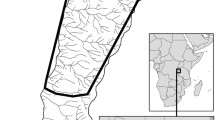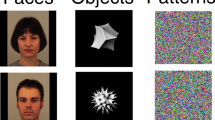Abstract
Using behaviourally-defined adjectives, observers rated individuals in a colony of rhesus monkeys on a seven-point scale. Principal component analysis of the ratings produced three main components: CI and CII were stable over three years, and CIII arose from the introduction of new items in the third year. Component I can be described as ranging fromConfident toFearful; and adult males scored higher on it than did adult females or one- to five-year olds. Component II ranged fromActive toSlow; and adult males scored higher on it than did adult females. Component III ranged fromSociable toSolitary; and adult males scored less on it than did adult females or one- to five-year olds. In addition, there was a positive correlation between scores of mothers and their one year olds on CI and CIII.
Similar content being viewed by others
References
Bem, D. J. &A. Allen, 1974. On predicting some of the people some of the time: the search for cross-situational consistencies in behaviour.Psych. Rev., 81: 506–520.
Bruner, J. S. &R. Tagiuri, 1954. The perception of people. In:Handbook of Social Psychology,I, G. Lindzey (ed.), Addison Wesley, Cambridge, Mass, pp. 601–633.
Buirski, P., H. Kellerman, R. Plutchik, &R. Weininger, 1973. A field study of emotions, dominance, and social behavior in a group of baboons (Papio anubis).Primates, 14: 67–78.
Chamove, A. S., H. J. Eysenck, &H. F. Harlow, 1972. Personality in monkeys: factor analysis of rhesus social behaviour.Quart J. Exp. Psychol., 24: 496–504.
Hope, K., 1968.Methods of Multivariate Analysis. University of London Press.
Kawai, M., 1958. On the system of social ranks in a natural troop of Japanese monkeys: I. Basic rank and dependent rank.Primates, 1: 111–130.
Kawamura, S., 1958. Matriarchal social ranks in the Minoo-B troop: a study of the rank system of Japanese monkeys.Primates, 1: 149–156.
Nie, N. H., C. H. Hull, J. G. Jenkins, K. Steinbrenner, & D. H. Bent, 1975.Statistical Package for the Social Sciences. second edition, McGraw-Hill.
Plutchik, R., 1970. Emotions, evolution and adaptive processes. In:Feelings and Emotions,M. Arnold (ed.), Academic Press, N.Y. pp 3–24.
Sade, D. S., 1967. Determinants of dominance in a group of free-ranging rhesus monkeys. In:Social Communication among Primates,S. Altmann (ed.), University of Chicago Press, pp 99–114.
Secord, P. F. &C. W. Backman, 1974.Social Psychology. McGraw-Hill, Tokyo.
Seyfarth, R. M., 1976. Social relationships among adult female baboons.Animal Behaviour, 24: 917–938.
Sheldon, W. H., 1942.The Varieties of Temperament. Harper, New York.
Siegel, S., 1956.Nonparametric Statistics for the Behavioral Sciences. McGraw-Hill, New York.
Author information
Authors and Affiliations
About this article
Cite this article
Stevenson-Hinde, J., Zunz, M. Subjective assessment of individual rhesus monkeys. Primates 19, 473–482 (1978). https://doi.org/10.1007/BF02373309
Received:
Accepted:
Issue Date:
DOI: https://doi.org/10.1007/BF02373309




